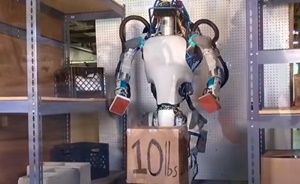.jpg?ext=.jpg)
The ANYmal robot walks through Onkalo's underground tunnels (Image: Tapani Karjanlahti / Posiva)
A four-legged robot designed for autonomous operation in challenging environments has been put through its paces at a depth of more than 400 metres in the tunnels of the Onkalo underground used nuclear fuel repository near Olkiluoto, Finland.
A research team led by the Swiss robotics company ANYbotics visited Olkiluoto in June to test the functionality of its ANYmal robot in underground facilities. The test was organised by Euratom - the European Atomic Energy Community - together with Finnish radioactive waste management company Posiva Oy.
The ANYmal robot has been under development for many years. The roots of the ANYbotics company go back to the Swiss Institute of Technology, EHT. A group of researchers from the educational institution built the first four-legged robot back in 2009, and ANYbotics was founded for the commercialisation of this technology in 2016.
The ANYmal robot uses laser sensors and cameras to observe the environment and can locate its own position very precisely. By combining observation data with location data - such as a map or area scan data - it can plan its navigation route independently when necessary.
Posiva said Onkalo offered a unique framework for the robot to move, noting that there are tunnels in other parts of the world, but no other underground disposal facility has yet been built.
During the test, the robot - measuring 93cm in length, 53cm in width and 89cm in height and weighing about 50kg - travelled through the tunnels of Onkalo for about 1.5 hours. With a fully-charged battery, the robot can operate for up to 2 hours. The purpose was to test how far the robot can travel in Onkalo conditions with one charge, and whether there are any terrains in the tunnel where the robot would not be able to advance.
For the test, the robot first "walked" the planned route by remote control, and scanned the map into its internal system. In the test itself, the robot moved along the scanned route autonomously, although all the time in the line of sight with the research team. It was also available for remote control at any moment, for example in case of danger. Various safety functions were programmed into the robot. For example, it went around the obstacles on the route from a certain safety distance and stopped when something came into its safety area.
Authorities are interested in the use of robots for the reason that a robot can reach places that are inaccessible to humans, for example for nuclear material protection inspection work. Carrying out nuclear safeguards with the help of a robot is also of interest to Posiva, the company said. Robots can also be used in rescue operations and industry. They can be equipped with different devices for different tasks, such as optical and thermal cameras, microphones, gas or radiation detectors.
A video of the ANYmal robot in Onkalo can be found here.Researched and written by World Nuclear News Source: - World Nuclear News

